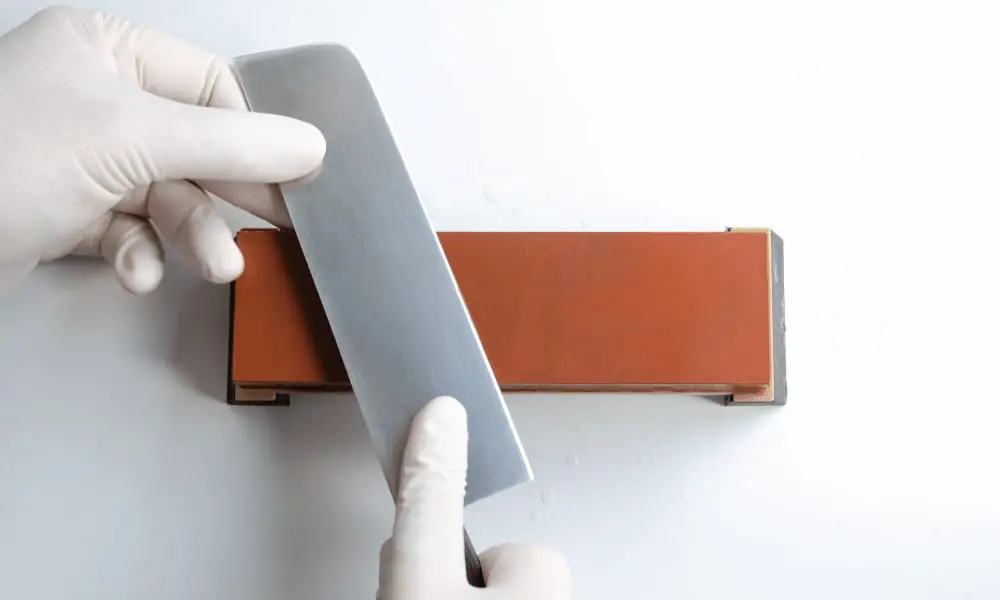The beautiful thing about a Nakiri knife is that it’s not only one of the most traditional Japanese knives, but to this day it’s still used for it’s original purpose and performs exceedingly well at it.
Other Japanese knives have been westernized, or blended between cultures, like the Santoku knife for example. However, the design, feel, and performance of a modern Nakiri knife matches almost exactly how the traditional ones were too.
Of course, the Nakiri knife has picked up a few more modern ways to use it effectively, but it still rings true to the olden days. That is, it’s a gorgeously versatile knife made for chopping, cutting, and slicing vegetables.
Here’s everything you need to know about the traditional and modern uses of a Nakiri Knife, how to use it correctly, and how to take care of your Japanese knives.
What Is A Nakiri Knife Used For?
In short, a Nakiri knife is a medium length Japanese kitchen knife designed to be ideal for chopping vegetables, herbs, and other greens.
It’s appearance is similar to the modern day meat cleaver, however it’s much lighter, sharper, more durable, and much more balanced for a seamless experience prepping any vegetables.
Plus of course, Japanese knives are at the pinnacle of craftsmanship. Being much tougher in hardness than German steel counterparts, which means they generally hold their sharp edge longer too. Not only that but they are often crafted at a much sharper angle, giving you the ability to make precise and clean cuts.
Nakiri Knife History

Unlike some of the more modern-day Japanese knives, like a Deba knife, or even more recently, a Santoku knife, the Nakiri knife dates back to as early as the 1600’s.
From the 1600s to 1860s, known as the Edo era, it was not allowed to consume any four-legged animals. Because of this, the diet of the Japanese was predominately made up of vegetables and fish – which gave birth to some very specialized knives.
The Nakiri knife, or “Nakiri bocho”, which translated to “knife for slicing greens”, became an incredibly popular and common knife used from homes to restaurants alike.
In fact, to this day this Nakiri knife is still used over more modern options such as the chef’s knife, Gyuto knife, and Santoku knife for cutting, slicing, and preparing vegetables.
Other Japanese knives specializing in filleting fish were introduced too, such as the Yanagiba knife or Deba knife.
What Are Nakiri Knives Used For Traditionally?
Traditionally the Nakiri was designed and crafted to be ideal for chopping, cutting, and slicing vegetables. From dense vegetables like onions, potatoes, and pumpkin to leafy greens like chard and cabbage and everything in between.
The square shape at the top of the knife doesn’t just look unique, it actually serves a very important purpose. Compared to a normal curved tip knife, the Nakiri has a lot more steel at the tip of the knife, which brings the balance of the blade forward.
This, paired with the straight edge of the knife, as opposed to circular edges, means it’s much more suited for chopping. As the knife comes down the entire blade contacts the chopping board at once.
Additionally, the wide surface area of the blade allows you to quickly and easily transfer large amounts of veggies into pots or frying pans for cooking, just making the whole job a lot smoother.
Modern Uses Of A Nakiri Knife

Since the Nakiri knife was designed to chop greens in excellent efficiency, it remains one of the best types of knives to be used for that purpose. Even in the modern day and age the Nakiri knife is almost unrivaled when it comes to vegetable preparation.
From soft vegetables to hard vegetables and everything in between. Even all types of fruits. The Nakiri is one of the best knives for cutting fruits as it’s got enough heft, sharpness, and precision to make whatever cuts you want.
The blade of the Nakiri knife also allows you to cut in a wide range of styles. This means that you can slice, dice, chop, and even julienne your fruits and veggies.
Not only that, but you can also use its thin blade to remove fruit flesh without having to switch to other tools.
The rectangular design also helps the vegetable knife to work in smaller herbs, garlic, onions, and more, which is great for portion control while adjusting the spices of your food.
How To Use A Nakiri Knife
The first steps to using any knife comes down to how you hold it. With a Nakiri knife, a normal grip will have you hold three fingers tucked up behind the blade gripping the handle, with your thumb and index finger pinching the base of the blade. This is known as the “pinch-grip”.
For an absolutely smashing demonstration, what the below video from Knifewear:
How To Take Care Of Your Nakiri Knife
Taking care of your Nakiri knife, or any other Japanese knife for that matter, takes a bit more conscious effort than some other lower quality knives you might have in your kitchen.
You want to preserve the integrity of the handle, avoid chipping the thinner blade, and causing any scratches on the surface of the blade ruining the beauty of the knife.
Once made routine, taking care of your Nakiri knife will become second nature. The top 4 tips to keeping it in pristine condition are:
- Always use a quality wooden cutting board for Japanese knives, or synthetic rubber. Avoid cutting on any surfaces like glass, marble, or countertops.
- Keep your Nakiri knife honed well. This means using a ceramic honing rod, which offers a much softer, non-scratch honing rod as opposed to steel honing rods.
- Keep your Nakiri knife evenly sharpened so that it doesn’t chip or wear while you’re cutting your tougher vegetables. Using a whetstone gives you the precision to make 10-12° degree edges, but a quality knife sharpener won’t hurt.
- Make sure to clean your knife by hand, and store it in a sheath, tucked away somewhere where it’s not going to bump into any other knives or kitchen utensils.
Final Thoughts
“Ahh yes” – the most common phrase used after using a Nakiri vegetable knife.
The Nakiri knife really is at the pinnacle of performance, and is revered as the absolute best knife for cutting vegetables. The versatility you get is amazing, not needing to change knives for any preparation task, whether it’s for small intricate cuts, or breaking down larger tougher vegetables.
I’m obsessed with Japanese knives, they are the perfect mix of beauty, performance, and elegance. If you are too, check out our other content about Japanese Knives.

